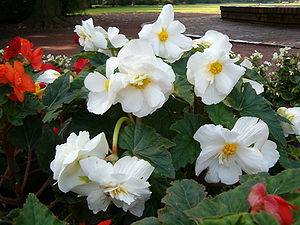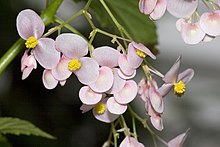Slate family
| Slate family | ||||||||||||
|---|---|---|---|---|---|---|---|---|---|---|---|---|

Tuberous begonias ( Begonia × tuberhybrida ) filled flowering varieties |
||||||||||||
| Systematics | ||||||||||||
|
||||||||||||
| Scientific name | ||||||||||||
| Begoniaceae | ||||||||||||
| Bercht. & J. Presl |
The slate family (Begoniaceae) are a family of plants within the order of the gourd-like (Cucurbitales). Only one of their more than 1800 species ( Hillebrandia sandwicensis ) does not belong to the genus Begonia . Many varieties of some species and hybrids from the genus Begonia are used as ornamental plants.
description




Habit and leaves
They rarely grow as annuals, usually as a perennial herbaceous plants and more rarely than half bushes to bushes that reach stature heights of only a few centimeters to 3 meters. Many species are more or less succulent . Many species form rhizomes or tubers. The stems can be erect, creeping, or drooping; sometimes they are also very short and the leaves are more or less in basal rosettes. They rarely climb with adventitious roots or form stolons .
The stipules envelop the petiole and stem . The alternate and spiral or two-line, basal or distributed on the stem arranged leaves are petiolate and often break easily. They usually have asymmetrical leaf blades, which are usually simple, rarely composed. The leaf edge can be serrated irregularly or sometimes smooth. The leaf blades are pinnate.
Inflorescences and flowers
Begonia plants are mostly monoecious and separate sexes ( monoecious ), so there are female and male flowers on one plant; They are seldom dioeciously separated sexes ( diocesan ), then there are purely female or male plants. The flowers are five-fold. In mostly lateral, branched total inflorescences, there are two to four or several, rarely many, dichotomous, zymous partial inflorescences; rarely is there only a single zymous inflorescence. The inflorescences and partial inflorescences are stalked and contain bracts .
The always unisexual flowers are more or less zygomorphic . The bloom cladding sheets are designed the same, so not separated into calyx and crown ( tepals ). In Hillebrandia ten bloom are present, which are differentiated into sepals and petals. Male flowers contain two or four cruciform, free bracts of which the outer two are usually larger. There are usually many, rarely only four, centripetal stamens . The stamens are mostly free or are rarely fused at their base; all stamens of the male flowers are fertile . Female flowers usually contain two to five, rarely up to ten bracts, which are usually free or rarely fused at their base. Most three (one to eight) carpels are one under constant ovary grown, which may be nodding, hanging or ascending. There are two, three or seldom more styluses that can be free or fused at their base and are bifurcated once or several times. The shape of the scar is very variable. Each ovary chamber contains 15 to 50 ovules . Female flowers can contain staminodes .
Fruits and seeds
They usually form dry, loculicidal capsule fruits , which are usually more or less asymmetrically winged or three to four horned and membranous. The capsule fruits contain a large number of very small seeds with a light brown, reticulate testa . Usually these fine seeds are the diaspores and are mostly spread by wind and rarely by raindrops. The fruits are rarely berry-like; they are the diaspores and are eaten by animals. There is no endosperm .
Chromosome number and ingredients
The basic chromosome number is variable x = 10–21 or more. The plants accumulate free oxalates .
distribution
Species of this family can be found worldwide in humid tropical and subtropical regions. Most of the species are native to South America. Only one species of Begonia grandis thrives in moderate latitudes in the western hills near Beijing and is also hardy in protected areas in Central Europe.
Systematics
The Begoniaceae family was published in 1820 under the name Begoniae Friedrich Graf von Berchtold and Jan Svatopluk Presl in Přirozenosti Rostlin , 1, p. 270 and then in 1824 with the name Begoniaceae by Carl Adolph Agardh in Aphorismi Botanici , 200.
There are only two genera left in the Begoniaceae family. In total more than 1800 species are assigned to this family, only one species belongs to a genus other than Begonia :
- Begonias ( Begonia L. ), also called slant leaf. The at least 1,800 species are divided into 63 to 66 sections. This makes it one of the most species-rich types of plants.
-
Hillebrandia Oliv. is a monotypical genus. It differs from Begonia mainly by a semi-subordinate, not completely overgrown ovary and by the bracts differentiated into sepals and petals. With the only kind:
- Hillebrandia sandwicensis olive. in Hawaii .
The earlier genus Symbegonia Warb. with about twelve species endemic to New Guinea (Swensen et al. 1998; Forrest & Hollingsworth 2003) is only one section of the genus Begonia . They differ from the other Begonia taxa in that the bracts on the female flowers are completely fused into a tube (name!). This is an adaptation to their pollinators, the nectar birds .
Within the order of the Cucurbitales , the Begoniaceae are most closely related to the Datiscaceae .
use
Some species, hybrids and their varieties of the genus Begonia are ornamental plants for parks, gardens and balconies worldwide . Over 130 species, hybrids and their varieties are cultivated as indoor plants because of their colorful foliage or their impressive flowers .
Begonia species are rarely used as food: The leaves of Begonia picta and Begonia palmata are eaten raw or cooked. The sour-tasting stems of Begonia picta are eaten pickled.
Medicinal effects of a few species were studied.
swell
- The Begoniaceae family on the AP website . (Sections systematics and description)
- The Begoniaceae family at DELTA by L. Watson & MJ Dallwitz. (Section description)
- Cuizhi Gu, Ching-I Peng, Nicholas J. Turland: Begoniaceae , p. 153 - online with the same text as the printed work , Wu Zheng-yi, Peter H. Raven, Deyuan Hong (eds.): Flora of China. Volume 13: Clusiaceae through Araliaceae , Science Press and Missouri Botanical Garden Press, Beijing and St. Louis, 2007, ISBN 978-1-930723-59-7 . (Section description)
- Shahina Ghazanfar, Parveen Aziz: Begoniaceae at Tropicos.org. In: Flora of Pakistan . Missouri Botanical Garden, St. Louis
Individual evidence
- ↑ a b Rafaël Govaerts (Ed.): Begoniaceae. In: World Checklist of Selected Plant Families (WCSP) - The Board of Trustees of the Royal Botanic Gardens, Kew . Retrieved September 19, 2018.
- ↑ a b c d e f Cuizhi Gu, Ching-I Peng, Nicholas J. Turland: Begoniaceae , p. 153 - online with the same text as the printed work , Wu Zheng-yi, Peter H. Raven, Deyuan Hong (ed.): Flora of China. Volume 13: Clusiaceae through Araliaceae , Science Press and Missouri Botanical Garden Press, Beijing and St. Louis, 2007, ISBN 978-1-930723-59-7 .
- ↑ a b c d The Begoniaceae family at DELTA by L. Watson & MJ Dallwitz.
- ↑ a b Laura Lowe Forrest, Mark Hughes, Peter M. Hollingsworth: A phylogeny of Begonia using nuclear ribosomal sequence data and non-molecular characters . In: Systematic Botany . tape 30 , 2005, pp. 671–682 ( online (PDF; 481 kB) ).
- ↑ a b c Wendy L. Clement, Mark C. Tebbitt, Laura L. Forrest, Jaime E. Blair, Luc Brouillet, Torsten Eriksson, Susan M. Swensen: Phylogenetic position and biogeography of Hillebrandia sandwicensis (Begoniaceae): a rare Hawaiian relict . In: American Journal of Botany . tape 91 , no. 6 , 2004, p. 905-917 ( full text online. ).
- ↑ Mark C. Tebbitt, Laura Lowe-Forrest, Anthony Santoriello, Wendy L. Clement, Susan M. Swensen: Phylogenetic Relationships of Asian Begonia, with an Emphasis on the Evolution of Rain-ballist and Animal Dispersal Mechanisms in Sections Platycentrum, Sphenanthera and Leprosae . In: Systematic Botany . tape 31 , no. 2 , 2006, p. 327-336 .
- ↑ Begoniaceae at Tropicos.org. In: IPCN Chromosome Reports . Missouri Botanical Garden, St. Louis
- ↑ Begoniaceae at Tropicos.org. Missouri Botanical Garden, St. Louis, accessed July 16, 2014.
- ↑ Laura Lowe Forrest, Peter M. Hollingsworth: A recircumscription of Begonia based on nuclear ribosomal sequences . In: Plant Systematics and Evolution . tape 241 , 2003, p. 193-211 .
- ↑ a b Begoniaceae at Plants For A Future